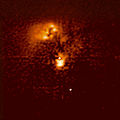Caelum
Caelum is a constellation in the southern sky. It is hard to see because it is not very bright. It means "the chisel" in Latin. Before, people called Caelum Scalptorium, which means "the engraver's chisel". It was created and named by the French astronomer named Nicolas Louis de Lacaille in the 1750s.[2] The brighest star in Caelum has a magnitude of 4.45.[3] This means that all of the stars in Caelum are too dark for people who live in cities to see.
 Click for larger image | |
| List of stars in Caelum | |
| Abbreviation: | Cae[1] |
| Genitive: | Caeli[1] |
| Symbology: | |
| Right ascension: | 5 h |
| Declination: | −40° |
| Area: | 125 sq. deg. (81st) |
| Main stars: | 4 |
| Bayer/Flamsteed stars: | 8 |
| Stars known to have planets: | 0 |
| Bright stars: | 0 |
| Nearby stars: | 1 |
| Brightest star: | α Cae (4.45m) |
| Nearest star: | RR Cae ( ly) |
| Messier objects: | 0 |
| Meteor showers: | None |
| Bordering constellations: | Columba Lepus Eridanus Horologium Dorado Pictor |
| Visible at latitudes between +40° and −90° Best visible at 21:00 (9 p.m.) during the month of January | |
Caelum Media
The constellation Caelum as it can be seen by the naked eye.
The Seyfert galaxy HE0450-2958, an unusual active galaxy in Caelum
References
- ↑ 1.0 1.1 Ridpath, Ian; Wil Tirion (2001), Stars and Planets Guide, Princeton University Press, pp. 90–91, ISBN 978-0-691-08913-3
- ↑ Ridpath, Ian. "Caelum: The Chisel". Star Tales. Retrieved 27 January 2013.
- ↑ "Alpha Caeli (HIP 21770)". Ashland Astronomy Studio. Retrieved 27 January 2013.[dead link]


